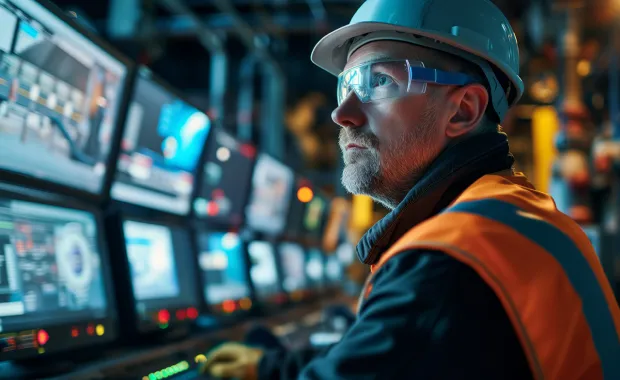The energy transition is a critical global imperative, essential for addressing challenges posed by climate change and steering our societies towards more sustainable practices. However, this transformation faces a significant hurdle: the shortage of skilled technical professionals. This talent gap is hindering not only innovation but also the implementation of the projects vital for facilitating this transition. The sectors most affected by this shortage are those at the heart of the energy transition, such as construction, energy and infrastructure.
Artificial intelligence (AI) is becoming a crucial ally in addressing workforce shortages across the energy and utilities sectors. As companies face challenges in finding skilled labor, AI offers innovative solutions to enhance productivity and streamline operations.
Gridlocked: Confronting skilled labor shortages in the energy sector
The energy sector is facing a critical shortage of skilled labor, particularly in vocational roles like electricians and STEM professionals, according to the International Energy Agency (IEA). Their 2023 World Energy Employment report indicates that global energy employment grew by 3.5 million from 2019 to 2022, with over half of this growth in solar, wind, electric vehicles (EVs), heat pumps, and critical mineral mining. However, the number of workers obtaining relevant degrees or certifications is not keeping pace with demand, exacerbating the skills gap in the industry.
Additionally, the transition to net zero emissions is projected to create 14 million new jobs by 2030, but this growth comes alongside an expected loss of 5 million fossil fuel jobs. The new roles often require different skill sets and are in areas distinct from where fossil fuel jobs are being lost, necessitating careful policy attention to manage these changes effectively.
The digital skills gap in Europe, which saw nearly four in five organizations in 2023 report that it is generally difficult to find workers with the right skills, prompted the European Commission to launch a strategic partnership for skills development. Further, the Progress of competitiveness of clean energy technologies report found that 25% of E.U. businesses involved in electrical equipment manufacturing faced shortages in the labor market.
The shortage of IT engineers is a problem affecting many countries. In Europe, an estimated 18 million people will need to be reskilled for the continent to reach its climate goals, and more than 1 million solar workers will be needed by 2030 to meet higher renewable energy targets. In the UK alone, 400,000 new recruits are needed in new and existing energy roles to meet the 2050 net zero emissions targets—30% more than the current oil and gas workforce available to fill these positions.
The employment rate of wind turbine technicians in the U.S. is expected to increase 60% over ten years while the global estimate for wind technicians needed to construct, install, operate and maintain the global onshore and offshore wind fleet by 2026 totals 568,800 people.
Additionally, the UK’s offshore industry—focused on meeting ambitious targets for increased offshore wind capacity—has warned it needs to attract and retain another 10,000 people every year by 2030, many of them in STEM (science, technology, engineering and math).
In Germany, there is an immediate need for experienced project managers for utility-scale projects, and additional skilled workers are required to keep pace with accelerated energy transition initiatives. In addition to IT and digital skills being critical for almost all energy jobs, there is also a high demand for regulatory compliance and data analysis professionals.
AI in the energy sector: powering possibilities in the face of talent shortages
AI's integration into the energy sector is revolutionizing workforce management by automating tasks and providing tailored training solutions, thereby boosting productivity, reducing strain on human resources, and creating demand for new skills.
AI is not just a tool for automation; it is reshaping the workforce landscape by:
- Enhancing human skills through automation of repetitive tasks.
- Providing valuable insights from data analysis to inform decision-making.
- Promoting a safer working environment through advanced training simulations.
Energy organizations are increasingly using AI-driven platforms for personalized learning and virtual reality simulations, enabling employees to practice essential skills amid a shortage of trained professionals. AI also enhances engineering project performance by automating tasks, optimizing schedules, and improving team agility.
Specifically, AI is addressing talent shortages in several key areas:
- Boosting productivity: Generative AI enhances productivity through predictive maintenance for grid systems, efficient energy storage, and demand-based distribution.
- Smart grid optimization: AI enables smart grids to optimize energy flow with minimal human oversight, improving efficiency and reliability.
- Continuous monitoring: In facility management, the combination of IoT and AI allows for ongoing structural health monitoring, promoting sustainability.
- Cybersecurity preparedness: A recent report revealed that 62% of utility respondents lack confidence in their cybersecurity skills. AI-integrated tools can enhance the detection of network anomalies and support a stretched cybersecurity workforce.
- Real-time threat detection: AI-powered SIEM systems analyze network traffic for suspicious patterns, automating vulnerability assessments in energy infrastructure.
- Innovative training solutions: Organizations are using AI-powered simulations for hands-on training and augmented reality for remote guidance during field operations.
- Predictive maintenance: AI-driven predictive maintenance helps forecast equipment failures, allowing for proactive scheduling based on data insights.
- Remote monitoring technologies: AI-powered drones and augmented reality systems facilitate remote inspections and diagnostics, enhancing operational efficiency.
While AI presents certain challenges, its value significantly outweighs these hurdles. The need for human oversight in complex decision-making ensures that AI is used responsibly and empathetically, enhancing its effectiveness. Additionally, effective AI relies on high-quality data, highlighting the importance of robust data governance strategies to maintain accuracy.
Although upfront investments and integration challenges exist, particularly in regions facing talent shortages, the transformative potential of AI in driving innovation and productivity makes it a worthwhile endeavor for organizations committed to progress.
AI and humanity: Partnering for a sustainable energy future
Addressing the talent shortage is crucial for the success of the energy transition. A comprehensive strategy that includes massive training initiatives, collaboration with educational institutions, and support for displaced workers is essential.
By leveraging AI and investing in upskilling programs, the industry can not only fill current gaps but also prepare for future demands. This integrated approach will ensure a sustainable and equitable transition to cleaner energy sources, ultimately enabling the successful completion of vital projects for a sustainable future.







